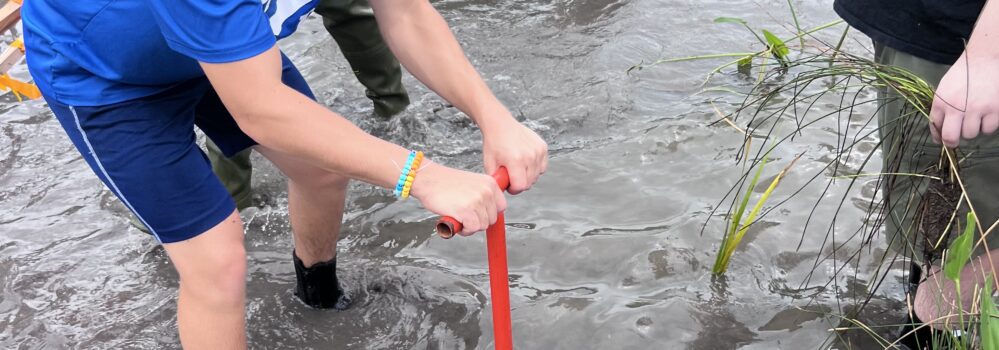
Students in Action: Creating the next generation of environmental stewards one event at a time
By Cindy Wilems, Director of Education – Galveston Bay Foundation
It’s a hot, sticky, almost windless day on Galveston Bay. Your feet are stuck ankle-deep in mud, almost falling over, laughing with your friends as you try your best to use something called a “dibble” to plant freshwater plants in a newly established pond. Not sure if or when you’ll end up falling into the water, your hands are coated in mud and your friend has it on his face. Although you feel absolutely disgusting and smelly, you know you’ll never forget this moment.
try your best to use something called a “dibble” to plant freshwater plants in a newly established pond. Not sure if or when you’ll end up falling into the water, your hands are coated in mud and your friend has it on his face. Although you feel absolutely disgusting and smelly, you know you’ll never forget this moment.
This is just a snapshot of what it’s like to participate in Galveston Bay Foundation’s (GBF’s) Students in Action program, which combines GBF’s restoration, citizen science, and education initiatives into a single day-long service-learning event. Occurring at crucial sites around Galveston Bay, third through twelfth-grade students from across the state of Texas are tasked with helping GBF restore, monitor, or clean up the environment.
Current projects include marine debris cleanups, nurdle collections, creating oyster reefs, restoring freshwater wetlands and prairie habitats, and monitoring the success of GBF-established oyster reefs and living shorelines.
In addition to helping the local environment, students participate in learning activities to establish a strong connection to WHY their help is important. While students are out with GBF’s Environmental Educators, they may use a seine net to see what organisms are found in a marsh, use insect nets to determine the biodiversity of the habitat, observe dolphin behavior at the Texas City Dike while talking about their use of echolocation in the turbid bay water, determine decomposition rates of marine debris, test water quality, and more.
These activities are designed to engage students in experiential, place-based learning to increase their connection to the local ecosystem.
“Picking up trash today, we TOGETHER were able to save the environment and the lives of insects and sea animals.”
– Student Participant
 Thank you to Restore America’s Estuaries and Citgo, GBF was able to purchase new wade booties, gloves, first aid items, and other essential supplies to support students participating in the Students in Action program. Providing items such as wade booties and gloves during field programs is an important step to increase the comfort level of participants.
Thank you to Restore America’s Estuaries and Citgo, GBF was able to purchase new wade booties, gloves, first aid items, and other essential supplies to support students participating in the Students in Action program. Providing items such as wade booties and gloves during field programs is an important step to increase the comfort level of participants.
For many students, participating in one of GBF’s Environmental STEM Education programs is their first true encounter with nature, and having a positive experience is crucial for the future of the region. GBF Educators meet participants where they are and create a safe place for everyone to learn, grow, and experience the wonders of Galveston Bay.
The overarching goals of the education programs are to instill knowledge and appreciation of the Galveston Bay ecosystem, inspire participants to break down barriers and open themselves to new experiences, and empower students to become life-long advocates for a resilient Galveston Bay. The programs provide STEM-based environmental education focused on the importance of the Galveston Bay estuarine system and how all the seemingly vastly different components—the Gulf of Mexico, rivers, lakes, bayous, woodlands, prairies, marshlands, farmlands, urban and suburban areas—are intertwined, interconnected, and greatly impact the Bay itself.
Fifteen schools and organizations have participated in the Students in Action program since January 2023, reaching over 500 participants from across the state. At each Students in Action event, students increase their connection with nature and realize how their actions, whether good or bad, can impact the environment. This realization is instrumental in creating a knowledgeable and skilled citizenry ready to tackle future environmental problems.
“They [students] realize the importance of recycling, reusing, the proper disposal of trash, their own environmental impact, and the importance of rebuilding and protecting marine life habitats.”
– Participating Group Leader
This project was funded through the 2023 round of the Caring for our Coast grant program. Click here to learn more.
